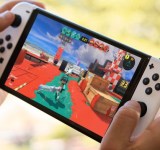The fighting genre is one that over the years has seen its fair share of variation in its art styles, formulae and dedicated fan bases. It’s a genre that generally limits itself to its strict rules sets that are difficult to break but can be easily bent to suit what the developers are aiming for. Slice, Dice and Rice are one of these such games that gives a different spin on infamous friendship breaking arena style of gameplay.
Inspired by the old PS1 classic Bushido Blade, SD&R sports no health bars and no combos, the general idea is to defeat your opponent in one clean swing. Baiting the opponent into giving you an opening combined with well-timed parries is the aim of the game and can often cause some really intense combat sequences.

The Cel-Shaded Mortal Kombat mixture in SD&R’s art style is delivered brilliantly and the characters move with fluidity, in which the game contains 10. All with different move sets, strengths, and weaknesses. All who possess their own story mode to boot. The most frustrating for myself to fight against was in Yoketsu, an Amazonian-like warrior who wields a gigantic two-handed sword and who’s movements are incredibly unpredictable and difficult to parry. The game itself is not one I would call difficult. I mean it can be tough but I felt that luck often came a close second to skill in this game as one lucky strike on to your enemy means a round win.

Time is relative in SD&R, slow-motion is often thrown into the energetic display of sparks and comic book style text as you land hits or parries to create an even more awesome sense of flashiness. I mean visual display at work here is actually quite remarkably simple and one that isn’t exactly new, but a simple cel-shade and an abundance of blood have always left its mark on me since watching Sin City.
This death screen had me giggling for a few moments

However, this is all well and positive but the nature of SD&R’s gameplay is sometimes to its own downfall. I love the reactive play style in the game and the lack of combos means that it’s easily accessible for new players but deep enough to cause it to be difficult to master. But as rounds are usually over within one slice of your sword, the stop and start of the game ruins pacing and you spend more time looking at screen phases, loading times and fighter intros. On top of that, the game features no online multiplayer, only local. Which can be a make or break for some gamers.

In summary, SD&R is a game that gives it a good go at being difficult, but the one hit nature of the game causes an imbalance that can actually cause it to become incredibly easy. The blood decals, textures, particle effects and art-style are fantastic and gameplay intense at times. Guilty of excelling in the Department of depth, but lacking in substance all the same. It’s a good game, I don’t contest it, it was especially fun to have intense battles on my couch with a friend. A long lasting fighting game to break the mould it is not, however. Sometimes game concepts in theory borderline on the verge of brilliance, but in practice can fall flat on its premise. I’ll definitely give the developers Dojo and A for ingenuity, but I can’t imagine myself getting excited to load up SD&R for a second run again.









You must be logged in to post a comment.